List of mammals of Nigeria
This is a list of the mammal species recorded in Nigeria. Of the mammal species in Nigeria, one is critically endangered, thirteen are endangered, sixteen are vulnerable, and ten are near threatened. One of the species listed for Nigeria can no longer be found in the wild.[1]
The following tags are used to highlight each species' conservation status as assessed by the International Union for Conservation of Nature:
| EX | Extinct | No reasonable doubt that the last individual has died. |
| EW | Extinct in the wild | Known only to survive in captivity or as a naturalized populations well outside its previous range. |
| CR | Critically endangered | The species is in imminent risk of extinction in the wild. |
| EN | Endangered | The species is facing an extremely high risk of extinction in the wild. |
| VU | Vulnerable | The species is facing a high risk of extinction in the wild. |
| NT | Near threatened | The species does not meet any of the criteria that would categorise it as risking extinction but it is likely to do so in the future. |
| LC | Least concern | There are no current identifiable risks to the species. |
| DD | Data deficient | There is inadequate information to make an assessment of the risks to this species. |
Some species were assessed using an earlier set of criteria. Species assessed using this system have the following instead of near threatened and least concern categories:
| LR/cd | Lower risk/conservation dependent | Species which were the focus of conservation programmes and may have moved into a higher risk category if that programme was discontinued. |
| LR/nt | Lower risk/near threatened | Species which are close to being classified as vulnerable but are not the subject of conservation programmes. |
| LR/lc | Lower risk/least concern | Species for which there are no identifiable risks. |
Order: Afrosoricida (tenrecs and golden moles)[]
The order Afrosoricida contains the golden moles of southern Africa and the tenrecs of Madagascar and Africa, two families of small mammals that were traditionally part of the order Insectivora.
- Family: Tenrecidae (tenrecs)
- Subfamily: Potamogalinae
- Genus: Potamogale
- Giant otter shrew, P. velox LC
- Genus: Potamogale
- Subfamily: Potamogalinae
Order: Tubulidentata (aardvarks)[]

The order Tubulidentata consists of a single species, the aardvark. Tubulidentata are characterised by their teeth which lack a pulp cavity and form thin tubes which are continuously worn down and replaced.
- Family: Orycteropodidae
- Genus: Orycteropus
- Aardvark, O. afer LC[2]
- Genus: Orycteropus
Order: Hyracoidea (hyraxes)[]
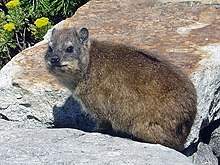
The hyraxes are any of four species of fairly small, thickset, herbivorous mammals in the order Hyracoidea. About the size of a domestic cat they are well-furred, with rounded bodies and a stumpy tail. They are native to Africa and the Middle East.
- Family: Procaviidae
Order: Proboscidea (elephants)[]

The elephants comprise three living species and are the largest living land animals.
- Family: Elephantidae (elephants)
Order: Sirenia (manatees and dugongs)[]
Sirenia is an order of fully aquatic, herbivorous mammals that inhabit rivers, estuaries, coastal marine waters, swamps, and marine wetlands. All four species are endangered.
- Family: Trichechidae
- Genus: Trichechus
- African manatee, T. senegalensis VU
- Genus: Trichechus
Order: Primates[]
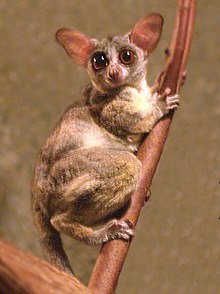
The order Primates contains humans and their closest relatives: lemurs, lorisoids, tarsiers, monkeys, and apes.
- Suborder: Strepsirrhini
- Infraorder: Lemuriformes
- Superfamily: Lorisoidea
- Family: Lorisidae
- Genus: Arctocebus
- Calabar angwantibo, Arctocebus calabarensis LR/nt
- Genus: Perodicticus
- West-African potto, Perodicticus (potto) potto LR/lc
- Milne-Edward's potto, Perodictus (potto) edwardsi LR/lc
- Genus: Arctocebus
- Family: Galagidae
- Genus: Sciurocheirus
- Bioko Allen's bushbaby, Sciurocheirus alleni LR/nt
- Genus: Galagoides
- Prince Demidoff's bushbaby, Galagoides demidovii LR/lc
- Thomas's bushbaby, Galagoides thomasi LR/lc
- Genus: Galago
- Senegal bushbaby, Galago senegalensis LR/lc
- Genus: Euoticus
- Northern needle-clawed bushbaby, Euoticus pallidus LR/nt
- Genus: Sciurocheirus
- Family: Lorisidae
- Superfamily: Lorisoidea
- Infraorder: Lemuriformes
- Suborder: Haplorhini
- Infraorder: Simiiformes
- Parvorder: Catarrhini
- Superfamily: Cercopithecoidea
- Family: Cercopithecidae (Old World monkeys)
- Genus: Erythrocebus
- Patas monkey, Erythrocebus patas LR/nt
- Genus: Chlorocebus
- Tantalus monkey, Chlorocebus tantalus LR/lc
- Genus: Cercopithecus
- White-throated guenon, Cercopithecus erythrogaster EN
- Red-eared guenon, Cercopithecus erythrotis VU
- Mona monkey, Cercopithecus mona LR/nt
- Greater spot-nosed monkey, Cercopithecus nictitans LR/nt
- Crowned guenon, Cercopithecus pogonias LR/lc
- Preuss's monkey, Cercopithecus preussi EN
- Putty-nosed monkey, Cercopithecus nictitans LR/nt
- Sclater's guenon, Cercopithecus sclateri EN
- Genus: Lophocebus
- Grey-cheeked mangabey, Lophocebus albigena VU
- Genus: Papio
- Olive baboon, Papio anubis LR/lc
- Genus: Cercocebus
- Collared mangabey, Cercocebus torquatus EN
- Genus: Mandrillus
- Drill, Mandrillus leucophaeus EN
- Subfamily: Colobinae
- Genus: Colobus
- Mantled guereza, Colobus guereza LR/lc
- Ursine colobus, Colobus vellerosus CR
- Genus: Procolobus
- Olive colobus, Procolobus verus VU
- Genus: Piliocolobus
- Niger Delta red colobus, Piliocolobus epieni CR
- Preuss's red colobus, Piliocolobus preussi CR
- Genus: Colobus
- Genus: Erythrocebus
- Family: Cercopithecidae (Old World monkeys)
- Superfamily: Hominoidea
- Family: Hominidae
- Subfamily: Homininae
- Tribe: Gorillini
- Genus: Gorilla
- Western gorilla, Gorilla gorilla CR
- Genus: Gorilla
- Tribe: Panini
- Genus: Pan
- Common chimpanzee, Pan troglodytes EN
- Genus: Pan
- Tribe: Gorillini
- Subfamily: Homininae
- Family: Hominidae
- Superfamily: Cercopithecoidea
- Parvorder: Catarrhini
- Infraorder: Simiiformes
Order: Rodentia (rodents)[]
Rodents make up the largest order of mammals, with over 40% of mammalian species. They have two incisors in the upper and lower jaw which grow continually and must be kept short by gnawing. Most rodents are small though the capybara can weigh up to 45 kg (99 lb).
- Suborder: Hystricognathi
- Family: Bathyergidae
- Genus: Cryptomys
- Nigerian mole-rat, Cryptomys foxi DD
- Genus: Cryptomys
- Family: Hystricidae (Old World porcupines)
- Genus: Hystrix
- Crested porcupine, Hystrix cristata LC
- Genus: Hystrix
- Family: Thryonomyidae (cane rats)
- Genus: Thryonomys
- Greater cane rat, Thryonomys swinderianus LC
- Genus: Thryonomys
- Family: Bathyergidae
- Suborder: Sciurognathi
- Family: Anomaluridae
- Subfamily: Anomalurinae
- Genus: Anomalurus
- Lord Derby's scaly-tailed squirrel, Anomalurus derbianus LC
- Genus: Anomalurops
- Beecroft's scaly-tailed squirrel, Anomalurops beecrofti LC
- Genus: Anomalurus
- Subfamily: Anomalurinae
- Family: Sciuridae (squirrels)
- Subfamily: Xerinae
- Tribe: Xerini
- Genus: Xerus
- Striped ground squirrel, Xerus erythropus LC
- Genus: Xerus
- Tribe: Protoxerini
- Genus: Funisciurus
- Thomas's rope squirrel, Funisciurus anerythrus DD
- Red-cheeked rope squirrel, Funisciurus leucogenys DD
- Fire-footed rope squirrel, Funisciurus pyrropus LC
- Genus: Heliosciurus
- Gambian sun squirrel, Heliosciurus gambianus LC
- Red-legged sun squirrel, Heliosciurus rufobrachium LC
- Genus: Paraxerus
- Cooper's mountain squirrel, Paraxerus cooperi DD
- Green bush squirrel, Paraxerus poensis LC
- Genus: Protoxerus
- Forest giant squirrel, Protoxerus stangeri LC
- Genus: Funisciurus
- Tribe: Xerini
- Subfamily: Xerinae
- Family: Gliridae (dormice)
- Subfamily: Graphiurinae
- Genus: Graphiurus
- Jentink's dormouse, Graphiurus crassicaudatus DD
- Lorrain dormouse, Graphiurus lorraineus LC
- Nagtglas's African dormouse, Graphiurus nagtglasii LC
- Kellen's dormouse, Graphiurus kelleni DD
- Genus: Graphiurus
- Subfamily: Graphiurinae
- Family: Dipodidae (jerboas)
- Family: Nesomyidae
- Subfamily: Dendromurinae
- Genus: Dendromus
- Gray climbing mouse, Dendromus melanotis LC
- Banana climbing mouse, Dendromus messorius LC
- Genus: Steatomys
- Northwestern fat mouse, Steatomys caurinus LC
- Dainty fat mouse, Steatomys cuppedius LC
- Jackson's fat mouse, Steatomys jacksoni VU
- Genus: Dendromus
- Subfamily: Cricetomyinae
- Genus: Cricetomys
- Emin's pouched rat, Cricetomys emini LC
- Gambian pouched rat, Cricetomys gambianus LC
- Genus: Cricetomys
- Subfamily: Dendromurinae
- Family: Muridae (mice, rats, voles, gerbils, hamsters, etc.)
- Subfamily: Deomyinae
- Genus: Acomys
- Johan's spiny mouse, Acomys johannis LC
- Genus: Lophuromys
- Rusty-bellied brush-furred rat, Lophuromys sikapusi LC
- Genus: Uranomys
- Rudd's mouse, Uranomys ruddi LC
- Genus: Acomys
- Subfamily: Otomyinae
- Genus: Otomys
- Western vlei rat, Otomys occidentalis VU
- Genus: Otomys
- Subfamily: Gerbillinae
- Genus: Desmodilliscus
- Pouched gerbil, Desmodilliscus braueri LC
- Genus: Gerbillus
- Sudan gerbil, Gerbillus nancillus DD
- Nigerian gerbil, Gerbillus nigeriae LC
- Genus: Tatera
- Kemp's gerbil, Tatera kempi LC
- Fringe-tailed gerbil, Tatera robusta LC
- Genus: Taterillus
- Gracile tateril, Taterillus gracilis LC
- Lake Chad gerbil, Taterillus lacustris LC
- Genus: Desmodilliscus
- Subfamily: Murinae
- Genus: Aethomys
- Tinfields rock rat, Aethomys stannarius NT
- Genus: Arvicanthis
- African grass rat, Arvicanthis niloticus LC
- Genus: Dasymys
- Fox's shaggy rat, Dasymys foxi VU
- West African shaggy rat, Dasymys rufulus LC
- Genus: Grammomys
- Shining thicket rat, Grammomys rutilans LC
- Genus: Hybomys
- Temminck's striped mouse, Hybomys trivirgatus LC
- Peters's striped mouse, Hybomys univittatus LC
- Genus: Hylomyscus
- Allen's wood mouse, Hylomyscus alleni LC
- Stella wood mouse, Hylomyscus stella LC
- Genus: Lemniscomys
- Typical striped grass mouse, Lemniscomys striatus LC
- Heuglin's striped grass mouse, Lemniscomys zebra LC
- Genus: Malacomys
- Edward's swamp rat, Malacomys edwardsi LC
- Big-eared swamp rat, Malacomys longipes LC
- Genus: Mastomys
- Guinea multimammate mouse, Mastomys erythroleucus LC
- Hubert's multimammate mouse, Mastomys huberti LC
- Verheyen's multimammate mouse, Mastomys kollmannspergeri LC
- Natal multimammate mouse, Mastomys natalensis LC
- Genus: Mus
- Hausa mouse, Mus haussa LC
- African pygmy mouse, Mus minutoides LC
- Peters's mouse, Mus setulosus LC
- Genus: Oenomys
- Common rufous-nosed rat, Oenomys hypoxanthus LC
- Genus: Praomys
- Dalton's mouse, Praomys daltoni LC
- Deroo's mouse, Praomys derooi LC
- Jackson's soft-furred mouse, Praomys jacksoni LC
- Gotel Mountain soft-furred mouse, Praomys obscurus EN
- Tullberg's soft-furred mouse, Praomys tullbergi LC
- Genus: Stochomys
- Target rat, Stochomys longicaudatus LC
- Genus: Aethomys
- Subfamily: Deomyinae
- Family: Anomaluridae
Order: Lagomorpha (lagomorphs)[]
The lagomorphs comprise two families, Leporidae (hares and rabbits), and Ochotonidae (pikas). Though they can resemble rodents, and were classified as a superfamily in that order until the early 20th century, they have since been considered a separate order. They differ from rodents in a number of physical characteristics, such as having four incisors in the upper jaw rather than two.
- Family: Leporidae (rabbits, hares)
- Genus: Lepus
- African savanna hare, L. victoriae LC[6]
- Genus: Lepus
Order: Erinaceomorpha (hedgehogs and gymnures)[]
The order Erinaceomorpha contains a single family, Erinaceidae, which comprise the hedgehogs and gymnures. The hedgehogs are easily recognised by their spines while gymnures look more like large rats.
- Family: Erinaceidae (hedgehogs)
- Subfamily: Erinaceinae
- Genus: Atelerix
- Four-toed hedgehog, Atelerix albiventris LR/lc
- Genus: Atelerix
- Subfamily: Erinaceinae
Order: Soricomorpha (shrews, moles, and solenodons)[]
The "shrew-forms" are insectivorous mammals. The shrews and solenodons closely resemble mice while the moles are stout-bodied burrowers.
- Family: Soricidae (shrews)
- Subfamily: Crocidurinae
- Genus: Crocidura
- Hun shrew, Crocidura attila LC
- Buettikofer's shrew, Crocidura buettikoferi LC
- Crosse's shrew, Crocidura crossei LC
- Dent's shrew, Crocidura denti LC
- Long-tailed musk shrew, Crocidura dolichura LC
- Doucet's musk shrew, Crocidura douceti DD
- Fox's shrew, Crocidura foxi LC
- Savanna shrew, Crocidura fulvastra LC
- Bicolored musk shrew, Crocidura fuscomurina LC
- Large-headed shrew, Crocidura grandiceps NT
- Lamotte's shrew, Crocidura lamottei LC
- Savanna swamp shrew, Crocidura longipes DD
- Mauritanian shrew, Crocidura lusitania LC
- Nigerian shrew, Crocidura nigeriae LC
- West African pygmy shrew, Crocidura obscurior LC
- African giant shrew, Crocidura olivieri LC
- Small-footed shrew, Crocidura parvipes LC
- Flat-headed shrew, Crocidura planiceps DD
- Fraser's musk shrew, Crocidura poensis LC
- Savanna path shrew, Crocidura viaria LC
- Voi shrew, Crocidura voi LC
- Yankari shrew, Crocidura yankariensis LC
- Genus: Suncus
- Etruscan shrew, Suncus etruscus LC
- Least dwarf shrew, Suncus infinitesimus LC
- Genus: Sylvisorex
- Cameroonian forest shrew, Sylvisorex camerunensis EN
- Climbing shrew, Sylvisorex megalura LC
- Greater forest shrew, Sylvisorex ollula LC
- Genus: Crocidura
- Subfamily: Crocidurinae
Order: Chiroptera (bats)[]
The bats' most distinguishing feature is that their forelimbs are developed as wings, making them the only mammals capable of flight. Bat species account for about 20% of all mammals.
- Family: Pteropodidae (flying foxes, Old World fruit bats)
- Subfamily: Pteropodinae
- Genus: Eidolon
- Straw-coloured fruit bat, Eidolon helvum LC
- Genus: Epomophorus
- Gambian epauletted fruit bat, Epomophorus gambianus LC
- Ethiopian epauletted fruit bat, Epomophorus labiatus LC
- Genus: Epomops
- Buettikofer's epauletted fruit bat, Epomops buettikoferi LC
- Franquet's epauletted fruit bat, Epomops franqueti LC
- Genus: Hypsignathus
- Hammer-headed bat, Hypsignathus monstrosus LC
- Genus: Lissonycteris
- Angolan rousette, Lissonycteris angolensis LC
- Smith's fruit bat, Lissonycteris smithi LC
- Genus: Micropteropus
- Peters's dwarf epauletted fruit bat, Micropteropus pusillus LC
- Genus: Myonycteris
- Little collared fruit bat, Myonycteris torquata LC
- Genus: Nanonycteris
- Veldkamp's dwarf epauletted fruit bat, Nanonycteris veldkampi LC
- Genus: Rousettus
- Egyptian fruit bat, Rousettus aegyptiacus LC
- Genus: Scotonycteris
- Zenker's fruit bat, Scotonycteris zenkeri NT
- Genus: Eidolon
- Subfamily: Macroglossinae
- Genus: Megaloglossus
- Woermann's bat, Megaloglossus woermanni LC
- Genus: Megaloglossus
- Subfamily: Pteropodinae
- Family: Vespertilionidae
- Subfamily: Kerivoulinae
- Genus: Kerivoula
- Lesser woolly bat, Kerivoula lanosa LC
- Smith's woolly bat, Kerivoula smithi LC
- Genus: Kerivoula
- Subfamily: Myotinae
- Genus: Myotis
- Rufous mouse-eared bat, Myotis bocagii LC
- Morris's bat, Myotis morrisi VU
- Genus: Myotis
- Subfamily: Vespertilioninae
- Genus: Eptesicus
- Lagos serotine, Eptesicus platyops DD
- Genus: Glauconycteris
- Beatrix's bat, Glauconycteris beatrix NT
- Abo bat, Glauconycteris poensis LC
- Butterfly bat, Glauconycteris variegata LC
- Genus: Mimetillus
- Moloney's mimic bat, Mimetillus moloneyi LC
- Genus: Neoromicia
- Dark-brown serotine, Neoromicia brunneus NT
- Cape serotine, Neoromicia capensis LC
- Tiny serotine, Neoromicia guineensis LC
- Banana pipistrelle, Neoromicia nanus LC
- Rendall's serotine, Neoromicia rendalli LC
- Somali serotine, Neoromicia somalicus LC
- White-winged serotine, Neoromicia tenuipinnis LC
- Genus: Nycticeinops
- Schlieffen's bat, Nycticeinops schlieffeni LC
- Genus: Pipistrellus
- Egyptian pipistrelle, Pipistrellus deserti LC
- Aellen's pipistrelle, Pipistrellus inexspectatus DD
- Tiny pipistrelle, Pipistrellus nanulus LC
- Rüppell's pipistrelle, Pipistrellus rueppelli LC
- Rusty pipistrelle, Pipistrellus rusticus LC
- Genus: Scotoecus
- Light-winged lesser house bat, Scotoecus albofuscus DD
- Hinde's lesser house bat, Scotoecus hindei DD
- Dark-winged lesser house bat, Scotoecus hirundo DD
- Genus: Scotophilus
- African yellow bat, Scotophilus dinganii LC
- White-bellied yellow bat, Scotophilus leucogaster LC
- Schreber's yellow bat, Scotophilus nigrita NT
- Nut-colored yellow bat, Scotophilus nux LC
- Greenish yellow bat, Scotophilus viridis LC
- Genus: Eptesicus
- Subfamily: Miniopterinae
- Genus: Miniopterus
- Common bent-wing bat, M. schreibersii VU[7]
- Genus: Miniopterus
- Subfamily: Kerivoulinae
- Family: Rhinopomatidae
- Genus: Rhinopoma
- Lesser mouse-tailed bat, Rhinopoma hardwickei LC
- Greater mouse-tailed bat, Rhinopoma microphyllum LC
- Genus: Rhinopoma
- Family: Molossidae
- Genus: Chaerephon
- Ansorge's free-tailed bat, Chaerephon ansorgei LC
- Gland-tailed free-tailed bat, Chaerephon bemmeleni LC
- Lappet-eared free-tailed bat, Chaerephon major LC
- Nigerian free-tailed bat, Chaerephon nigeriae LC
- Little free-tailed bat, Chaerephon pumila LC
- Genus: Mops
- Sierra Leone free-tailed bat, Mops brachypterus LC
- Angolan free-tailed bat, Mops condylurus LC
- Midas free-tailed bat, Mops midas LC
- Dwarf free-tailed bat, Mops nanulus LC
- Railer bat, Mops thersites LC
- Trevor's free-tailed bat, Mops trevori VU
- Genus: Myopterus
- Bini free-tailed bat, Myopterus whitleyi LC
- Genus: Tadarida
- Egyptian free-tailed bat, Tadarida aegyptiaca LC
- Genus: Chaerephon
- Family: Emballonuridae
- Genus: Coleura
- African sheath-tailed bat, Coleura afra LC
- Genus: Saccolaimus
- Pel's pouched bat, Saccolaimus peli NT
- Genus: Taphozous
- Mauritian tomb bat, Taphozous mauritianus LC
- Naked-rumped tomb bat, Taphozous nudiventris LC
- Egyptian tomb bat, Taphozous perforatus LC
- Genus: Coleura
- Family: Nycteridae
- Genus: Nycteris
- Bate's slit-faced bat, Nycteris arge LC
- Gambian slit-faced bat, Nycteris gambiensis LC
- Large slit-faced bat, Nycteris grandis LC
- Hairy slit-faced bat, Nycteris hispida LC
- Large-eared slit-faced bat, Nycteris macrotis LC
- Egyptian slit-faced bat, Nycteris thebaica LC
- Genus: Nycteris
- Family: Megadermatidae
- Genus: Lavia
- Yellow-winged bat, Lavia frons LC
- Genus: Lavia
- Family: Rhinolophidae
- Subfamily: Rhinolophinae
- Genus: Rhinolophus
- Halcyon horseshoe bat, Rhinolophus alcyone LC
- Darling's horseshoe bat, Rhinolophus darlingi LC
- Rüppell's horseshoe bat, Rhinolophus fumigatus LC
- Hildebrandt's horseshoe bat, Rhinolophus hildebrandti LC
- Hill's horseshoe bat, Rhinolophus hillorum VU
- Lander's horseshoe bat, Rhinolophus landeri LC
- Bushveld horseshoe bat, Rhinolophus simulator LC
- Genus: Rhinolophus
- Subfamily: Hipposiderinae
- Genus: Hipposideros
- Aba roundleaf bat, Hipposideros abae NT
- Benito roundleaf bat, Hipposideros beatus LC
- Sundevall's roundleaf bat, Hipposideros caffer LC
- Cyclops roundleaf bat, Hipposideros cyclops LC
- Sooty roundleaf bat, Hipposideros fuliginosus NT
- Giant roundleaf bat, Hipposideros gigas LC
- Jones's roundleaf bat, Hipposideros jonesi NT
- Noack's roundleaf bat, Hipposideros ruber LC
- Genus: Hipposideros
- Subfamily: Rhinolophinae
Order: Pholidota (pangolins)[]
The order Pholidota comprises the eight species of pangolin. Pangolins are anteaters (not to be confused with the taxonomical anteaters) and have the powerful claws, elongated snout and long tongue seen in the other unrelated anteater species.
- Family: Manidae
Order: Cetacea (whales)[]

The order Cetacea includes whales, dolphins and porpoises. They are the mammals most fully adapted to aquatic life with a spindle-shaped nearly hairless body, protected by a thick layer of blubber, and forelimbs and tail modified to provide propulsion underwater.
- Suborder: Mysticeti
- Family: Balaenopteridae
- Subfamily: Balaenopterinae
- Genus: Balaenoptera
- Common minke whale, Balaenoptera acutorostrata LC
- Antarctic minke whale, Balaenoptera bonaerensis DD
- Sei whale, Balaenoptera borealis EN
- Bryde's whale, Balaenoptera edeni DD
- Blue whale, Balaenoptera musculus EN
- Fin whale, Balaenoptera physalus EN
- Genus: Balaenoptera
- Subfamily: Megapterinae
- Genus: Megaptera
- Humpback whale, Megaptera novaeangliae VU
- Genus: Megaptera
- Subfamily: Balaenopterinae
- Family: Balaenopteridae
- Suborder: Odontoceti
- Superfamily: Platanistoidea
- Family: Physeteridae
- Genus: Physeter
- Sperm whale, Physeter macrocephalus VU
- Genus: Physeter
- Family: Kogiidae
- Genus: Kogia
- Pygmy sperm whale, K. breviceps DD[11]
- Dwarf sperm whale, Kogia sima
- Genus: Kogia
- Family: Ziphidae
- Subfamily: Hyperoodontinae
- Genus: Mesoplodon
- Blainville's beaked whale, Mesoplodon densirostris DD
- Gervais' beaked whale, Mesoplodon europaeus DD
- Genus: Ziphius
- Cuvier's beaked whale, Ziphius cavirostris DD
- Genus: Mesoplodon
- Subfamily: Hyperoodontinae
- Family: Delphinidae (marine dolphins)
- Genus: Steno
- Rough-toothed dolphin, Steno bredanensis DD
- Genus: Tursiops
- Common bottlenose dolphin, Tursiops truncatus LC
- Genus: Delphinus
- Long-beaked common dolphin, Delphinus capensis DD
- Genus: Stenella
- Pantropical spotted dolphin, Stenella attenuata LR/cd
- Striped dolphin, Stenella coeruleoalba LR/cd
- Atlantic spotted dolphin, Stenella frontalis DD
- Clymene dolphin, Stenella clymene DD
- Spinner dolphin, Stenella longirostris LR/cd
- Genus: Lagenodelphis
- Fraser's dolphin, Lagenodelphis hosei DD
- Genus: Sousa
- Atlantic humpback dolphin, Sousa teuszii
- Genus: Orcinus
- Genus: Feresa
- Pygmy killer whale, Feresa attenuata DD
- Genus: Pseudorca
- False killer whale, Pseudorca crassidens LR/lc
- Genus: Globicephala
- Short-finned pilot whale, Globicephala macrorhynchus LR/cd
- Genus: Peponocephala
- Melon-headed whale, Peponocephala electra DD
- Genus: Steno
- Family: Physeteridae
- Superfamily: Platanistoidea
Order: Carnivora (carnivorans)[]
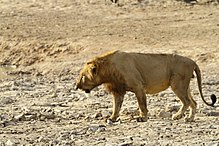

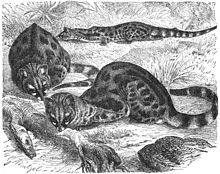


There are over 260 species of carnivorans, the majority of which feed primarily on meat. They have a characteristic skull shape and dentition.
- Suborder: Feliformia
- Family: Felidae (cats)
- Family: Viverridae
- Subfamily: Viverrinae
- Genus: Civettictis
- African civet, C. civetta LC[18]
- Genus: Genetta
- Crested servaline genet, G. cristata VU[19]
- Common genet, G. genetta LC[20]
- Rusty-spotted genet, G. maculata LC[21]
- Hausa genet, G. thierryi LC[22]
- Genus: Civettictis
- Subfamily: Viverrinae
- Family: Nandiniidae
- Genus: Nandinia
- African palm civet, N. binotata LC[23]
- Genus: Nandinia
- Family: Herpestidae (mongooses)
- Genus: Atilax
- Marsh mongoose, A. paludinosus LC[24]
- Genus: Bdeogale
- Black-footed mongoose, B. nigripes LC[25]
- Genus: Crossarchus
- Flat-headed kusimanse, C. platycephalus LC[26]
- Genus: Herpestes
- Genus: Ichneumia
- White-tailed mongoose, I. albicauda LC[29]
- Genus: Mungos
- Genus: Xenogale
- Long-nosed mongoose, X. naso LC[32]
- Genus: Atilax
- Family: Hyaenidae (hyaenas)
- Suborder: Caniformia
- Family: Canidae (dogs, foxes)
- Family: Mustelidae (mustelids)
Order: Artiodactyla (even-toed ungulates)[]

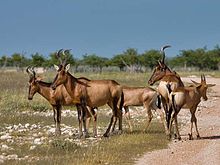
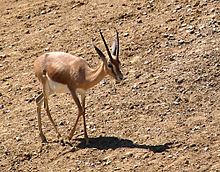

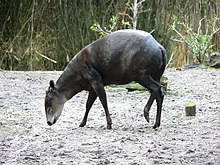



The even-toed ungulates are ungulates whose weight is borne about equally by the third and fourth toes, rather than mostly or entirely by the third as in perissodactyls. There are about 220 artiodactyl species, including many that are of great economic importance to humans.
- Family: Suidae (pigs)
- Subfamily: Phacochoerinae
- Genus: Phacochoerus
- Common warthog, Phacochoerus africanus
- Genus: Phacochoerus
- Subfamily: Suinae
- Genus: Hylochoerus
- Giant forest hog, Hylochoerus meinertzhageni
- Genus: Potamochoerus
- Red river hog, Potamochoerus porcus
- Genus: Hylochoerus
- Subfamily: Phacochoerinae
- Family: Hippopotamidae (hippopotamuses)
- Genus: Choeropsis
- Pygmy hippopotamus, C. liberiensis EN extirpated
- Genus: Hippopotamus
- Hippopotamus, H. amphibius VU[44]
- Genus: Choeropsis
- Family: Tragulidae
- Genus: Hyemoschus
- Water chevrotain, Hyemoschus aquaticus DD
- Genus: Hyemoschus
- Family: Giraffidae (giraffe, okapi)
- Genus: Giraffa
- Giraffe, Giraffa camelopardalis VU extirpated
- Genus: Giraffa
- Family: Bovidae (cattle, antelope, sheep, goats)
- Subfamily: Alcelaphinae
- Genus: Alcelaphus
- Hartebeest, A. buselaphus LC[45]
- Genus: Damaliscus
- Korrigum, Damaliscus lunatus LR/cd
- Genus: Alcelaphus
- Subfamily: Antilopinae
- Genus: Gazella
- Dorcas gazelle, Gazella dorcas VU possibly extirpated
- Red-fronted gazelle, Gazella rufifrons VU
- Genus: Nanger
- Dama gazelle, Nanger dama CR extirpated, vagrant
- Genus: Neotragus
- Bates's pygmy antelope, Neotragus batesi LR/nt
- Genus: Oreotragus
- Klipspringer, Oreotragus oreotragus LR/cd
- Genus: Ourebia
- Oribi, Ourebia ourebi LR/cd
- Genus: Gazella
- Subfamily: Bovinae
- Subfamily: Cephalophinae
- Genus: Cephalophus
- Bay duiker, Cephalophus dorsalis LR/nt
- Maxwell's duiker, Cephalophus maxwellii LR/nt
- Blue duiker, Cephalophus monticola LR/lc
- Black duiker, Cephalophus Niger LR/nt
- Black-fronted duiker, Cephalophus nigrifrons LR/nt
- Ogilby's duiker, Cephalophus ogilbyi LR/nt
- Red-flanked duiker, Cephalophus rufilatus LR/cd
- Yellow-backed duiker, Cephalophus silvicultor LR/nt
- Genus: Sylvicapra
- Common duiker, Sylvicapra grimmia LR/lc
- Genus: Cephalophus
- Subfamily: Hippotraginae
- Genus: Hippotragus
- Roan antelope, Hippotragus equinus LR/cd
- Genus: Oryx
- Scimitar oryx, Oryx dammah EW
- Genus: Hippotragus
- Subfamily: Reduncinae
- Genus: Kobus
- Waterbuck, Kobus ellipsiprymnus LR/cd
- Kob, Kobus kob LR/cd
- Genus: Redunca
- Mountain reedbuck, Redunca fulvorufula LC
- Bohor reedbuck, Redunca redunca LR/cd
- Genus: Kobus
- Subfamily: Alcelaphinae
See also[]
- List of chordate orders
- Lists of mammals by region
- List of prehistoric mammals
- Mammal classification
- List of mammals described in the 2000s
References[]
- ^ This list is derived from the IUCN Red List which lists species of mammals and includes those mammals that have recently been classified as extinct (since 1500 AD). The taxonomy and naming of the individual species is based on those used in existing Wikipedia articles as of 21 May 2007 and supplemented by the common names and taxonomy from the IUCN, Smithsonian Institution, or University of Michigan where no Wikipedia article was available.
- ^ Taylor, A. & Lehmann, T. (2015). "Orycteropus afer". IUCN Red List of Threatened Species. 2015: e.T41504A21286437.
- ^ Butynski, T.; Hoeck, H.; Koren, L. & de Jong, Y.A. (2015). "Procavia capensis". IUCN Red List of Threatened Species. 2015: e.T41766A21285876.
- ^ Gobush, K.S.; Edwards, C.T.T.; Balfour, D.; Wittemyer, G.; Maisels, F.; Taylor, R.D. (2021). "Loxodonta africana". IUCN Red List of Threatened Species. 2021: e.T181008073A204401095. doi:10.2305/IUCN.UK.2021-2.RLTS.T181008073A204401095.en. Retrieved 18 November 2021.
- ^ Gobush, K.S.; Edwards, C.T.T.; Maisels, F.; Wittemyer, G.; Balfour, D.; Taylor, R.D. (2021). "Loxodonta cyclotis". IUCN Red List of Threatened Species. 2021: e.T181007989A204404464. doi:10.2305/IUCN.UK.2021-1.RLTS.T181007989A204404464.en. Retrieved 18 November 2021.
- ^ Johnston, C.H.; Robinson, T.J.; Relton, C.; Child, M.F. & Smith, A.T. (2019). "Lepus victoriae". IUCN Red List of Threatened Species. 2019: e.T41879A45194215.
- ^ Gazaryan, S.; Bücs, S. & Çoraman, E. (2020). "Miniopterus schreibersii". IUCN Red List of Threatened Species. 2020: e.T81633057A151216401.
- ^ Ingram, D.J.; Shirley, M.H.; Pietersen, D.; Godwill Ichu, I.; Sodeinde, O.; Moumbolou, C.; Hoffmann, M.; Gudehus, M. & Challender, D. (2019). "Phataginus tetradactyla". IUCN Red List of Threatened Species. 2019: e.T12766A123586126.
- ^ Pietersen, D.; Moumbolou, C.; Ingram, D.J.; Soewu, D.; Jansen, R.; Sodeinde, O.; Keboy Mov Linkey Iflankoy, C.; Challender, D. & Shirley, M.H. (2019). "Phataginus tricuspis". IUCN Red List of Threatened Species. 2019: e.T12767A123586469.
- ^ Nixon, S.; Pietersen, D.; Challender, D.; Hoffmann, M.; Godwill Ichu, I.; Bruce, T.; Ingram, D.J.; Matthews, N. & Shirley, M.H. (2019). "Smutsia gigantea". IUCN Red List of Threatened Species. 2019: e.T12762A123584478.
- ^ Taylor, B.L.; Baird, R.; Barlow, J.; Dawson, S.M.; Ford, J.K.B.; Mead, J.G.; Notarbartolo di Sciara, G.; Wade, P. & Pitman, R.L. (2012). "Kogia breviceps". IUCN Red List of Threatened Species. 2012: e.T11047A17692192.
- ^ Reeves, R.; Pitman, R.L. & Ford, J.K.B. (2017). "Orcinus orca". IUCN Red List of Threatened Species. 2017: e.T15421A50368125.
- ^ Bahaa-el-din, L.; Mills, D.; Hunter, L. & Henschel, P. (2015). "Caracal aurata". IUCN Red List of Threatened Species. 2015: e.T18306A50663128.
- ^ Avgan, B.; Henschel, P. & Ghoddousi, A. (2016). "Caracal caracal". IUCN Red List of Threatened Species. 2016: e.T3847A102424310.
- ^ Thiel, C. (2015). "Leptailurus serval". IUCN Red List of Threatened Species. 2015: e.T11638A50654625.
- ^ Bauer, H.; Packer, C.; Funston, P. F.; Henschel, P. & Nowell, K. (2016). "Panthera leo". IUCN Red List of Threatened Species. 2016: e.T15951A115130419.
- ^ Stein, A.B.; Athreya, V.; Gerngross, P.; Balme, G.; Henschel, P.; Karanth, U.; Miquelle, D.; Rostro-Garcia, S.; Kamler, J. F.; Laguardia, A.; Khorozyan, I. & Ghoddousi, A. (2019). "Panthera pardus". IUCN Red List of Threatened Species. 2019: e.T15954A160698029.
- ^ Do Linh San, E.; Gaubert, P.; Wondmagegne, D. & Ray, J. (2015). "Civettictis civetta". IUCN Red List of Threatened Species. 2015: e.T41695A45218199.
- ^ Gaubert, P.; Angelici, F.M. & Do Linh San, E. (2015). "Genetta cristata". IUCN Red List of Threatened Species. 2015: e.T8998A45198406.
- ^ Gaubert, P.; Carvalho, F.; Camps, D. & Do Linh San, E. (2015). "Genetta genetta". IUCN Red List of Threatened Species. 2015: e.T41698A45218636.
- ^ Angelici, F.M.; Gaubert, P. & Do Linh San, E. (2016). "Genetta maculata". IUCN Red List of Threatened Species. 2016: e.T41699A45218948.
- ^ Gaubert, P. & Do Linh San, E. (2015). "Genetta thierryi". IUCN Red List of Threatened Species. 2015: e.T41701A45219325.
- ^ Gaubert, P.; Bahaa-el-din, L.; Ray, J. & Do Linh San, E. (2015). "Nandinia binotata". IUCN Red List of Threatened Species. 2015: e.T41589A45204645.
- ^ Do Linh San, E.; Angelici, F. M.; Maddock, A. H.; Baker, C. M. & Ray, J. (2015). "Atilax paludinosus". IUCN Red List of Threatened Species. 2015: e.T41590A45204865.
- ^ Angelici, F. M. & Do Linh San, E. (2015). "Bdeogale nigripes". IUCN Red List of Threatened Species. 2015: e.T41592A45205243.
- ^ Angelici, F. M. & Do Linh San, E. (2016). "Crossarchus platycephalus". IUCN Red List of Threatened Species. 2016: e.T41596A45205626.
- ^ Do Linh San, E.; Maddock, A.H.; Gaubert, P. & Palomares, F. (2016). "Herpestes ichneumon". IUCN Red List of Threatened Species. 2016: e.T41613A45207211.
- ^ Do Linh San, E. & Maddock, A.H. (2016). "Herpestes sanguineus". IUCN Red List of Threatened Species. 2016: e.T41606A45206143.
- ^ Do Linh San, E. (2015). "Ichneumia albicauda". IUCN Red List of Threatened Species. 2015: e.T41620A45208640.
- ^ Sillero-Zubiri, C. & Do Linh San, E. (2016). "Mungos gambianus". IUCN Red List of Threatened Species. 2016: e.T13922A45199653.
- ^ Gilchrist, J.S. & Do Linh San, E. (2016). "Mungos mungo". IUCN Red List of Threatened Species. 2016: e.T41621A45208886.
- ^ Ray, J.; Bahaa-el-din, L.; Angelici, F. M. & Do Linh San, E. (2015). "Herpestes naso". IUCN Red List of Threatened Species. 2015: e.T41615A45207915.
- ^ Bohm, T. & Höner, O.R. (2015). "Crocuta crocuta". IUCN Red List of Threatened Species. 2015: e.T5674A45194782.
- ^ AbiSaid, M. & Dloniak, S.M.D. (2015). "Hyaena hyaena". IUCN Red List of Threatened Species. 2015: e.T10274A45195080.
- ^ Sillero-Zubiri, C. & Wacher, T. (2012). "Vulpes pallida". IUCN Red List of Threatened Species. 2012: e.T23052A16813736.
- ^ Hoffmann, M. & Atickem, A. (2019). "Canis lupaster". IUCN Red List of Threatened Species. 2019: e.T118264888A118265889.
- ^ Woodroffe, R. & Sillero-Zubiri, C. (2020). "Lycaon pictus". IUCN Red List of Threatened Species. 2020: e.T12436A166502262.
- ^ Ahmim, M. & Do Linh San, E. (2015). "Ictonyx libyca". IUCN Red List of Threatened Species. 2015: e.T41645A45212347.
- ^ Stuart, C.; Stuart, M.; Do Linh San, E. (2015). "Ictonyx striatus". IUCN Red List of Threatened Species. 2015: e.T41646A45212491.
- ^ Do Linh San, E.; Begg, C.; Begg, K. & Abramov, A. V. (2016). "Mellivora capensis". IUCN Red List of Threatened Species. 2016: e.T41629A45210107.
- ^ Reed-Smith, J.; Jacques, H. & Somers, M.J. (2015). "Hydrictis maculicollis". IUCN Red List of Threatened Species. 2015: e.T12420A21936042.
- ^ Jacques, H.; Reed-Smith & Somers, M.J. (2015). "Aonyx capensis". IUCN Red List of Threatened Species. 2015: e.T1793A21938767.
- ^ Jacques, H.; Reed-Smith, J.; Davenport, C.; Somers, M.J. (2015). "Aonyx congicus". IUCN Red List of Threatened Species. 2015: e.T1794A14164772.
- ^ Lewison, R. & Pluháček, J. (2017). "Hippopotamus amphibius". IUCN Red List of Threatened Species. 2017: e.T10103A18567364.
- ^ IUCN SSC Antelope Specialist Group (2019). "Alcelaphus buselaphus". IUCN Red List of Threatened Species. 2019: e.T811A143160967.
- ^ IUCN SSC Antelope Specialist Group (2019). "Syncerus caffer". IUCN Red List of Threatened Species. 2019: e.T21251A50195031.
External links[]
- "Animal Diversity Web". University of Michigan Museum of Zoology. 1995–2006. Retrieved 22 May 2007.
- Lists of mammals by location
- Lists of mammals of Africa
- Lists of biota of Nigeria
- Mammals of West Africa